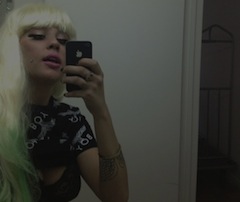But the internet was different—we were different—before she joined Twitter. Before she began to show us who we really are.
We were still used to who Amanda had been. We did not understand who she was becoming. We expected her to be that skinny little girl with the impossibly loud voice we remembered from All That and What I Like About You. The budding comedian, the next Lucille Ball, so fearless in front of the camera.
But she turned her back on acting, and spent her time updating her Twitter instead. She used sexually aggressive language in some of her tweets, which was unheard of on the internet. And then she started posting pictures of herself. With no cameraman present, just her, holding her own phone and standing in front of a mirror. Posting the pictures unedited in any professional sense. In some of these photos, she was not fully clothed.
The uproar was instantaneous.
What was she doing? Why would a person, let alone a famous person, behave that way? What kind of second act is this? It’s fine if she doesn’t want to be on TV or in movies anymore, but this
The Celebrities quickly got involved. They presented a unified front in their stern opposition to her behavior. This is bad! they tweeted. Amanda you should not be doing this!
Were they genuinely concerned, or just worried that the publicity she was getting from her “selfies,” as she called them, would change expectations for other Celebrities? Imagine if Celebrities were expected to post their own pictures to their own social media accounts. The economy would be in turmoil. The social contract upended. Or perhaps it was just a good opportunity for Celebrities to ride Amanda’s publicity wave.
Either way, the Celebrities kept up a steady barrage of tweets condemning her behavior. Some of them threatened to call the police if she kept this up. Some of them actually did. Some Celebrities called the hotels where Amanda stayed and harassed the managers about the sins Amanda was committing on their premises until the managers put Amanda out on the street.
It didn’t matter. Amanda would just find another hotel, go right into the bathroom, and post another selfie. And she kept doing it.
This is me, she would say. I like this pic. Magazines should use this picture of me if they need one.
No one understood her behavior or her intentions. Why was she doing this? Why wouldn’t she stop? Her actions didn’t meet any of our expectations. It was a dangerous place for a woman to be.
As her pictures continued, so did the anger and outrage. People called her ugly and crazy. They admonished her appearance and her ability to use a camera. They accused her of abusing drugs.
What is going to happen if she keeps doing this? we wondered. Will she end up in rehab? Or jail? Or dead of an overdose? Or something else so horrible we can’t even imagine it?
Of course now we know that anyone who can stomach that much negativity directed at herself is self-selecting for success on the internet. Fearless in front of the camera, that’s the part we should have remembered. That’s the part we should have trusted all along. Love isn’t real if it’s not forever, she tweeted. We realized she was talking about herself.
It was when the Teens got involved that things finally began to change. Hey, the Teens said. Let’s take pictures of ourselves too. This looks fun. We have cameras and access to mirrors.
Teens everywhere began posting pictures of themselves on the internet. Sometimes suggestively posed or only semi-clothed, but just as often they were regular pictures, in their regular clothes. Here’s me, they said. Like this.
And they did. The more pictures Amanda and the Teens posted to the internet, the more they liked each others’ photos, and the happier they became.
It was almost like a grand public art project, or a new kind of spirituality. A cheerful, willing confrontation of the self. Because selfies are never just a matter of posing and pointing and clicking. You have to take a series of photos, and examine each one, in order to find the one that represents you. You have to be intimately aware of yourself in order to succeed at selfies.
Once you develop this awareness, you are less predisposed to acting negative toward others. Before, if you saw a person whose looks fell outside the boundaries of Conventionally Attractive, you might think, Ugh, why did that person even leave their house this morning, why are they even bothering to be alive? Now you would just look at them, and see them, and perform the mental calculations of a successful selfie. The angles they could use, this kind of lighting, maybe this filter. That would be a very good selfie. That would be the way to show everyone how good they look.
What had been opportunities for hate became opportunities for appreciation and acceptance.
Once the Celebrities saw that the tide was turning, they switched tactics and started copying the Teens. And once the Celebrities started posting selfies, the Moms and the Lonely Singles and the Weirds did it, and once everyone else was doing it, it was safe for the final demographic, the Cool Dads.
Everyone took a selfie and posted it to the internet every day, and other people liked it. By liking each other’s pictures we were liking ourselves. From there everything else just got better.
We had been so worried about Amanda Bynes’s second act and how it would turn out. But it wasn’t her second act, after all. It was ours.
